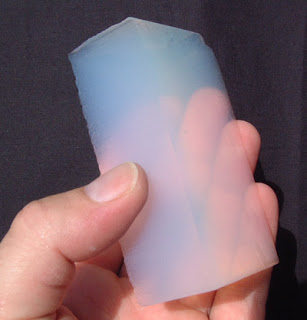Sấy khô Aerogel bằng công nghệ chất lỏng siêu tới hạn
Aerogels | Uses for Supercritical Fluids


Aerogel – Vật liệu siêu xốp trong công nghệ sấy CO₂ siêu tới hạn
Tổng quan
Aerogel là vật liệu có độ xốp cực cao, với diện tích bề mặt trong rất lớn và thể tích mao quản đáng kể.
Mật độ của chúng có thể thấp đến 3 kg/m³, trong khi độ rỗng đạt tới 99,9%, khiến aerogel trở thành chất cách nhiệt tuyệt vời.
Quá trình hình thành cấu trúc siêu xốp này diễn ra trong môi trường dung môi (thường là ethanol) thông qua phản ứng sol-gel.
Vấn đề khi sấy khô aerogel
Khi aerogel được lấy ra khỏi bể dung môi để sử dụng, việc sấy khô gặp nhiều khó khăn nghiêm trọng.
Do cấu trúc mạng của aerogel rất mảnh, quá trình sấy thông thường ở áp suất khí quyển sẽ làm sụp đổ mạng lưới mao quản, biến vật liệu thành bụi mịn.
Nguyên nhân là do áp suất mao dẫn (capillary pressure) xuất hiện tại bề mặt phân cách lỏng – hơi bên trong các lỗ xốp.
Giải pháp bằng chất siêu tới hạn
Chất siêu tới hạn (supercritical fluids) có sức căng bề mặt rất thấp, cả ở giao diện với pha lỏng lẫn giao diện với pha khí.
Chính đặc tính này cho phép sấy khô aerogel mà không phá hủy cấu trúc của nó.
Ba phương pháp sấy khô aerogel phổ biến
- Chuyển dung môi hữu cơ sang trạng thái siêu tới hạn ở nhiệt độ cao, sau đó xả áp ra môi trường.
- Thay thế dung môi hữu cơ bằng CO₂ lỏng, sau đó xả CO₂ siêu tới hạn.
- Chiết tách dung môi hữu cơ bằng CO₂ siêu tới hạn ở nhiệt độ thấp.
Phương pháp 1 – Sấy khô bằng dung môi hữu cơ ở trạng thái siêu tới hạn
Trong phương pháp này, dung môi hữu cơ lỏng (ví dụ ethanol) được gia nhiệt vượt quá nhiệt độ tới hạn của nó (243°C).
Dung môi được tăng áp vượt quá áp suất tới hạn, sau đó xả ra áp suất khí quyển trong khi vẫn duy trì nhiệt độ cao, cho phép bay hơi dung môi mà không làm sụp cấu trúc xốp.

Phương pháp 2 – Thay thế dung môi hữu cơ bằng CO₂ lỏng và xả CO₂ siêu tới hạn
Trong phương pháp phổ biến hơn này, ethanol (hoặc dung môi hữu cơ tương tự) được thay thế bằng CO₂ lỏng.
Hệ thống sau đó được nén đến áp suất lớn hơn 73 atm và gia nhiệt vượt quá 31°C, tức là vượt qua điểm siêu tới hạn của CO₂.
Khi CO₂ đã đạt trạng thái siêu tới hạn, quá trình giảm áp (xả áp) được thực hiện trong khi vẫn duy trì nhiệt độ trên 31°C.
Nhờ đó, CO₂ siêu tới hạn thoát ra, mang theo dung môi hữu cơ còn sót lại — giúp loại bỏ hoàn toàn dung môi mà không phá vỡ cấu trúc xốp tinh vi của aerogel.

Phương pháp 3 – Chiết tách dung môi hữu cơ bằng CO₂ siêu tới hạn ở nhiệt độ thấp
Tương tự như phương pháp thay thế bằng CO₂ lỏng, trong phương pháp này ethanol được thay thế trực tiếp bằng CO₂ siêu tới hạn.
Sau khi quá trình thay thế hoàn tất, CO₂ siêu tới hạn được giảm áp (xả áp) trong khi vẫn duy trì nhiệt độ trên 31°C — tức là trên điểm tới hạn của CO₂.
Nhờ đặc tính của CO₂ siêu tới hạn (độ nhớt thấp, sức căng bề mặt gần như bằng không, khả năng khuếch tán cao), dung môi hữu cơ được chiết tách hoàn toàn mà không làm sụp đổ cấu trúc mao quản tinh vi của aerogel.

Bình luận
Tin tức khác
Công nghệ chiết tách bằng phương pháp CO2 ở trạng thái siêu tới hạn (SCO2)
Công nghệ trích ly sử dụng CO2 siêu tới hạn nâng giá trị quả gấc
Nâng chất lượng dầu gấc bằng công nghệ trích ly Carbonic siêu tới hạn.
Sử dụng chất lỏng siêu tới hạn chiết xuất Vi tảo
Ứng dụng công nghệ chiết xuất CO2 siêu tới hạn trong chiết xuất Piperin trong hạt tiêu đen
Sử dụng công nghệ CO2 siêu tới hạn trong chế biến thực phẩm
Chiết xuất tinh dầu bằng công nghệ CO2 lỏng siêu tới hạn
Chiết xuất Nutraceuticals bằng công nghệ CO2 siêu tới hạn
Chiết chọn lọc các axit béo và Carotenoids từ Vi tảo bằng công nghệ CO2 siêu tới hạn
Chiết xuất adenosine bằng công nghệ CO2 siêu tới hạn từ trùng thảo
Nghiên cứu chiết xuất tinh dầu bằng công nghệ CO2 siêu tới hạn từ cây cỏ thiên nhiên của Việt Nam
Chiết Xuất Saponin trong Nhân Sâm Bằng Công Nghệ CO2 Siêu Tới Hạn
Các ứng dụng của CO2 siêu tới hạn
CO2 siêu tới hạn-Những tiến bộ trong hóa học xanh
Lưu chất siêu tới hạn và ứng dụng CO2 siêu tới hạn trích ly hương liệu, tinh chất trong công nghệ chế biến thực phẩm
Nghiên cứu chiết xuất astaxanthin từ H. pluvialis bằng công nghệ CO2 siêu tới hạn
Chiết xuất dầu Gấc bằng công nghệ CO2 siêu tới hạn
Máy sấy lạnh
Aerogel- Vật liệu của thế kỷ
Hoạt độ nước trong thực phẩm (aw)
Latex cao su thiên nhiên cô đặc-yêu cầu kỹ thuật theo TCVN 6314:2013
Loại bỏ Protein trong cao su thiên nhiên bằng Urê
TCVN 9239:2012 CHẤT THẢI RẮN - QUY TRÌNH CHIẾT ĐỘC TÍNH
Kết nối với chúng tôi
